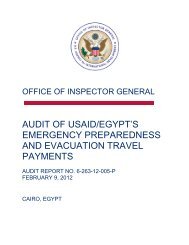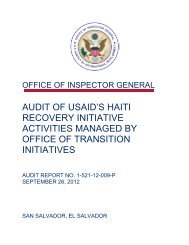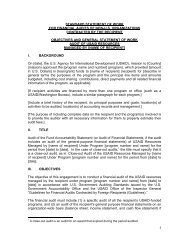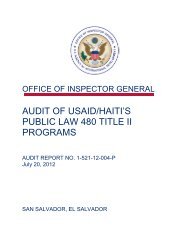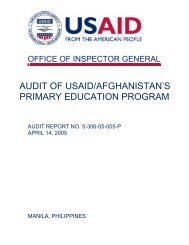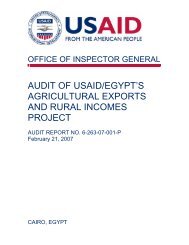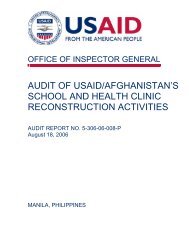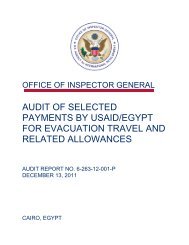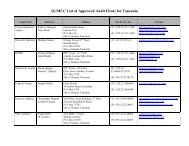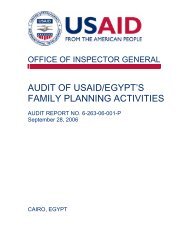USAID OIG Afghanistan and Pakistan Oversight Report, April-June ...
USAID OIG Afghanistan and Pakistan Oversight Report, April-June ...
USAID OIG Afghanistan and Pakistan Oversight Report, April-June ...
- No tags were found...
You also want an ePaper? Increase the reach of your titles
YUMPU automatically turns print PDFs into web optimized ePapers that Google loves.
According to information provided by the selected implementing partners, they made $13.5 million in cashpayments in 2010, representing 7 percent of the $181.1 million in total costs they incurred in <strong>Afghanistan</strong>.For individual implementing partners, cash payments as a percentage of total costs incurred in <strong>Afghanistan</strong>ranged from 2 to 69 percent. The types of costs paid in cash included office supplies, local travel, prepaidphone cards, utilities, <strong>and</strong> maintenance. The implementing partners that had a higher percentage of costspaid in cash also used cash for programmatic activities such as small grants, cash-for-work programs, <strong>and</strong>microfinance loans.Overall, <strong>OIG</strong> auditors determined that audited cash expenditures were reasonable, allocable, <strong>and</strong> allowable.However, no controls can completely eliminate the risk of fraud, loss, <strong>and</strong> personal harm to staff associatedwith h<strong>and</strong>ling <strong>and</strong> transporting cash in a war zone. And, following the review, five of the ten selectedimplementing partners took steps to reduce their cash exposure risk by proactively seeking ways to makepayments through electronic funds transfers, check, or hawala transfers. The selected implementingpartners also implemented a number of best practices for managing cash disbursements that other<strong>USAID</strong>/<strong>Afghanistan</strong> implementing partners should consider adopting.Audit of <strong>USAID</strong>/<strong>Afghanistan</strong>’s Agriculture, Water, <strong>and</strong> Technology Transfer Program (<strong>Report</strong> No. F-306-11-001-P, February 13, 2011)According to <strong>USAID</strong>/<strong>Afghanistan</strong>, nearly 80 percent of Afghans earn their living from agriculture.<strong>USAID</strong>/<strong>Afghanistan</strong>’s active agriculture <strong>and</strong> alternative livelihoods programs, with reported obligations of$701 million <strong>and</strong> disbursements of $494 million as of September 30, 2010, were designed to create jobs <strong>and</strong>increase incomes in the agricultural sector <strong>and</strong> increase Afghans’ confidence in their government,particularly in the Ministry of Agriculture, Irrigation <strong>and</strong> Livestock. One such program, the <strong>Afghanistan</strong>Agriculture, Water, <strong>and</strong> Technology Transfer Program, is implemented through a $20 million cooperativeagreement with New Mexico State University (NMSU).The objective of this audit was to determine whether the program was achieving its main goals, which dealtwith irrigation water management, agricultural technology transfer, <strong>and</strong> institution building. Two-<strong>and</strong>-ahalfyears into the 3-year program, NMSU had achieved a number of successes in introducing newagricultural <strong>and</strong> water technologies, <strong>and</strong> many farmers were participating in on-farm demonstrations ofthese technologies. Auditors found some evidence of dem<strong>and</strong> for these new technologies—such as laserguidedequipment for leveling l<strong>and</strong> for surface irrigation—but adoption of the technologies remained in thefuture.Financial records for the program showed that about 61 percent of spending was in <strong>Afghanistan</strong>, while theother 39 percent was in the United States. Officials connected with the program raised concerns that thehigh proportion of expenditures in the United States left fewer resources available for activities in<strong>Afghanistan</strong> <strong>and</strong> raised other questions about the financial management of the program. To address theseissues, <strong>OIG</strong> contracted with an audit firm to conduct financial audits of NMSU <strong>and</strong> its partner universities inthe United States <strong>and</strong> issued a separate report with audit results.<strong>USAID</strong>’s cooperative agreement with NMSU also established the development of an institutional frameworkfor effective management of the country’s limited water resources as a key objective. NMSU demonstrated anumber of water-conserving technologies <strong>and</strong> successfully stimulated dem<strong>and</strong> for some of them. However,76 <strong>USAID</strong> <strong>OIG</strong> <strong>Afghanistan</strong> <strong>and</strong> <strong>Pakistan</strong> <strong>Oversight</strong> <strong>Report</strong>



